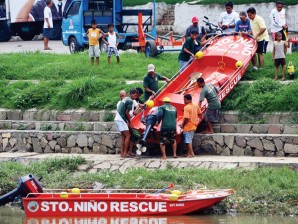
GETTING READY. Members of a rescue team in Marikina City bring a boat down to the Marikina River as part of the local government’s preparations for the coming of Typhoon “Chedeng.” MARIANNE BERMUDEZ
MANILA, Philippines—Tropical storm “Chedeng” intensified into a typhoon on Wednesday with winds gusting up to 160 kilometers per hour, prompting the evacuation of thousands and disrupting air and sea transport, officials said.
Albay Gov. Joey Salceda dispatched six military trucks to begin the evacuation of some 200,000 people making up 42,000 families in Legazpi City and 13 other towns prone to landslides and flooding as a preemptive measure.
Similar evacuations were being carried out in Camarines Sur, said Office of Civil Defense (OCD) officials.
The Coast Guard reported ferry services had been suspended, stranding 1,330 passengers bound for the Visayas at the port of Matnog in Sorsogon province. Another 2,000 people were marooned in ports in other areas of Bicol and in Allen, Northern Samar province.
The Manila International Airport Authority said commercial flights from the cities of Davao, Iloilo and Butuan were diverted on Wednesday to Clark International Airport in Pampanga province because of poor visibility caused by heavy rains in the capital. Flights to Naga City and Boracay were canceled.
As of 5 p.m. Wednesday, the Philippine Atmospheric, Geophysical and Astronomical Services Administration (Pagasa) said Chedeng had accelerated and maintained its strength. It changed course slightly earlier in the day, and was moving northwest at 15 kph.
The typhoon, with center winds of 130 kph, was spotted 310 km east of Catarman, Northern Samar.
Signal No. 2 was hoisted over the provinces of Catanduanes, Sorsogon, Albay, Camarines Sur, Camarines Norte and Samar, while Signal No. 1 was up in Marinduque, Masbate, Burias and Ticao Islands, Quezon, Polillo Island, Aurora, northern Leyte and Biliran Island provinces.
Pagasa said that by this evening, Chedeng is expected to be 140 km northeast of Virac, Catanduanes, or 230 km north of Catarman. By Friday evening, the typhoon is expected to be 150 km north-northeast of Baler, Aurora province, and by Saturday evening, at 40 km west of Basco, Batanes.
Landfall on Friday
Pagasa expected the typhoon to hit the Aurora-Isabela area on Friday or Saturday.
Chedeng may also move westward and hit Samar, Bicol and Metro Manila, chief Pagasa forecaster Robert Sawi said in a press briefing.
Science Undersecretary Graciano Yumul warned officials of Samar and Bicol to prepare for a possible direct hit.
President Benigno Aquino III will be on a two-day visit to Thailand starting Thursday, but he will be kept informed of developments, said his spokesperson, Edwin Lacierda. “So the President will be on top of the situation and we will be reporting to the President.”
Benito Ramos, executive director of the National Disaster Risk Reduction and Management Council (NDRRMC), said soldiers had been mobilized to help evacuate thousands from areas prone to landslides and floods in Sorsogon, Albay and Catanduanes.
The retired general said the evacuation was a response to the President’s “zero casualty” order. “We can mitigate the effects of the disaster but we cannot prevent the occurrence of the disaster,” he said.
Disaster alerts
In Aurora, Gov. Bellaflor Angara-Castillo said food, medicines and vehicles for disaster response had been deployed and evacuation centers prepared.
In Nueva Ecija, at least eight houses were destroyed, while several others were damaged when a tornado hit a riverside village in Cabiao town amid heavy rains on Tuesday night.
Emelita Cabales, 42, a resident of Barangay Sta. Rita, said she saw the twister coming from a nearby river before it hit the houses at about 6 p.m.
In Bulacan, personnel at Angat Dam said they were hoping that rains would increase the water level at the reservoir, which has been dropping due to lack of heavy rainfall in the past weeks.
Angat Dam supplies 97 percent of the water requirements of Metro Manila and irrigates farms in Bulacan and Pampanga.
The water level at Ipo Dam, at the lower portion of Angat, and San Roque Dam in Pangasinan were still below spilling level, officials said.
Road repair
In Dagupan, Vladimir Mata, the city administrator, ordered disaster response councils to be on alert and to disseminate updated weather bulletins. “Emphasis should be on proactive actions—evacuation than rescue,” Mata said.
In the Cordillera, public works personnel were sent to critical mountain roads on Tuesday because rains had triggered landslides in Benguet, Ifugao and Mt. Province, said OCD officer Ronald Villa.
“The rains were not even brought about by Typhoon Chedeng, so we want to be certain the roads would survive the typhoon should it come our way,” Villa said.
Some 900 soldiers and reservists under the National Capital Region Command who are helping out in the Department of Education’s school cleanup campaign are ready to switch to disaster response mode, said Gen. Eduardo Oban Jr., Armed Forces chief of staff.
Oban also put military units on alert for disaster response and relief.
The National Grid Corp. of the Philippines, operator of the country’s electricity superhighway, said it had activated command centers to prepare for power outages and damage to transmission lines. With reports from Dona Z. Pazzibugan, Tina G. Santos, Amy R. Remo, Christine O. Avendaño, and Jocelyn R. Uy in Manila; Mar S. Arguelles, Inquirer Southern Luzon; Tonette Orejas, Armand Galang and Carmela Reyes, Inquirer Central Luzon; Yolanda Sotelo and Vincent Cabreza, Inquirer Northern Luzon; and Joey Gabieta and Rachel Arnaiz, Inquirer Visayas